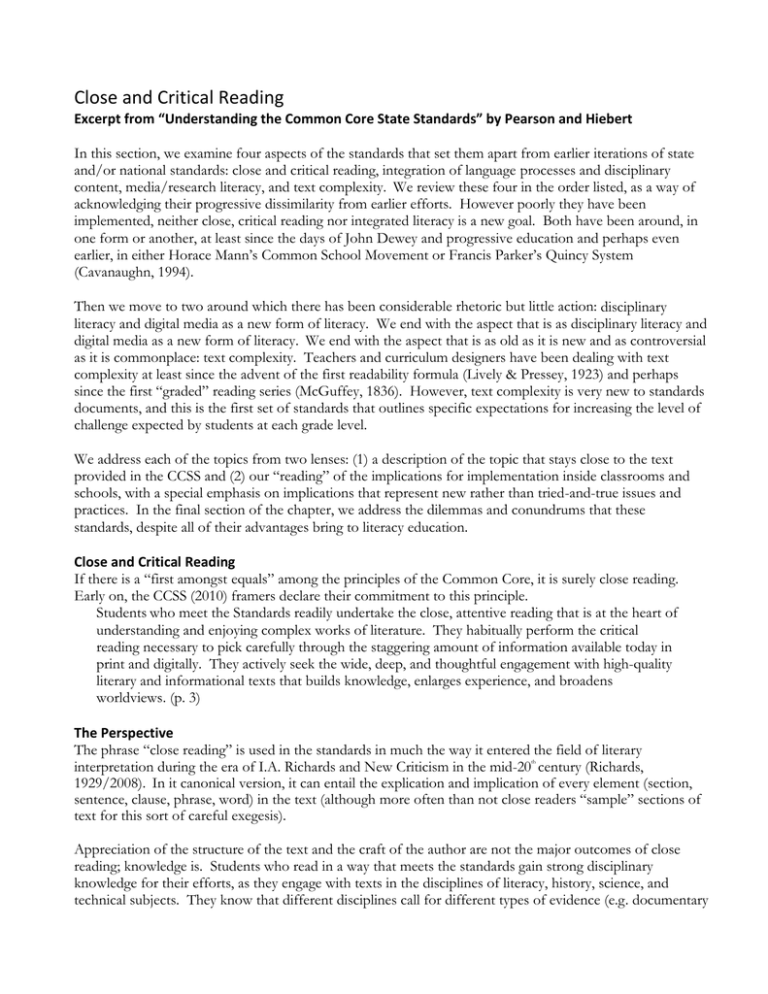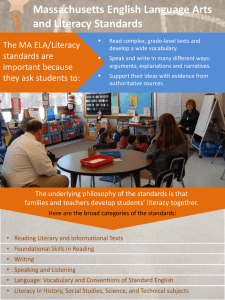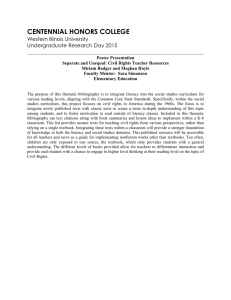Close and Critical Reading
advertisement

Close and Critical Reading Excerpt from “Understanding the Common Core State Standards” by Pearson and Hiebert In this section, we examine four aspects of the standards that set them apart from earlier iterations of state and/or national standards: close and critical reading, integration of language processes and disciplinary content, media/research literacy, and text complexity. We review these four in the order listed, as a way of acknowledging their progressive dissimilarity from earlier efforts. However poorly they have been implemented, neither close, critical reading nor integrated literacy is a new goal. Both have been around, in one form or another, at least since the days of John Dewey and progressive education and perhaps even earlier, in either Horace Mann’s Common School Movement or Francis Parker’s Quincy System (Cavanaughn, 1994). Then we move to two around which there has been considerable rhetoric but little action: disciplinary literacy and digital media as a new form of literacy. We end with the aspect that is as disciplinary literacy and digital media as a new form of literacy. We end with the aspect that is as old as it is new and as controversial as it is commonplace: text complexity. Teachers and curriculum designers have been dealing with text complexity at least since the advent of the first readability formula (Lively & Pressey, 1923) and perhaps since the first “graded” reading series (McGuffey, 1836). However, text complexity is very new to standards documents, and this is the first set of standards that outlines specific expectations for increasing the level of challenge expected by students at each grade level. We address each of the topics from two lenses: (1) a description of the topic that stays close to the text provided in the CCSS and (2) our “reading” of the implications for implementation inside classrooms and schools, with a special emphasis on implications that represent new rather than tried-and-true issues and practices. In the final section of the chapter, we address the dilemmas and conundrums that these standards, despite all of their advantages bring to literacy education. Close and Critical Reading If there is a “first amongst equals” among the principles of the Common Core, it is surely close reading. Early on, the CCSS (2010) framers declare their commitment to this principle. Students who meet the Standards readily undertake the close, attentive reading that is at the heart of understanding and enjoying complex works of literature. They habitually perform the critical reading necessary to pick carefully through the staggering amount of information available today in print and digitally. They actively seek the wide, deep, and thoughtful engagement with high-quality literary and informational texts that builds knowledge, enlarges experience, and broadens worldviews. (p. 3) The Perspective The phrase “close reading” is used in the standards in much the way it entered the field of literary interpretation during the era of I.A. Richards and New Criticism in the mid-20 century (Richards, 1929/2008). In it canonical version, it can entail the explication and implication of every element (section, sentence, clause, phrase, word) in the text (although more often than not close readers “sample” sections of text for this sort of careful exegesis). th Appreciation of the structure of the text and the craft of the author are not the major outcomes of close reading; knowledge is. Students who read in a way that meets the standards gain strong disciplinary knowledge for their efforts, as they engage with texts in the disciplines of literacy, history, science, and technical subjects. They know that different disciplines call for different types of evidence (e.g. documentary evidence in history, experimental evidence in science, textual clues in literature) and ways of formulating arguments to support claims about how the world works. Above all, students value evidence as the basic currency of academic discourse, and they are able to evaluate the claims made by the authors of texts and those that they make themselves in crafting arguments about the ideas they encounter in these texts. One might anticipate that such a commitment to acquiring knowledge and constructing precise arguments achieves those goals at a cost; and the most likely candidate is an erosion of commitment to multicultural contribution and perspectives in literature, art, history, and science. Not so. The stands express clear commitments to cultural diversity. Early in the document, the standards announce this commitment clearly: “Students actively seek to understand other perspectives and cultures through reading and listening, and they are able to communicate effectively with people of varied backgrounds” (NGA and CCSSO, 2010, p. 4). Commitment to diversity does not imply unexamined acceptance of the ideas in the diverse array of texts students encounter. To the contrary, the same analytic and critical lenses that enable readers to critique and construct arguments are brought to bear on all texts they encounter. They evaluate other points of view critically and constructively. Close reading is meant to occur both within and across texts reflecting the general disposition of the standards that students are always trying to connect the ideas they encounter in a given text with other ideas from a range of sources, including previously read texts, their prior experiences, and other media (e.g., digital content). Implications for Implementation In our discussion of implications for close reading, one might expect us to focus on the first cluster (Standards 1-3) of Key Ideas and Details. After all, isn’t a clear exposition of what the text says the natural result of close reading? While this might be true in a very narrow sense of what it means to read closely, this perspective misses the point of close reading. We read closely to acquire knowledge, but we cannot acquire that knowledge except in relation to what we already know; hence the significance of the third cluster of standards: Integration of Knowledge and Ideas (Standards 7-9). We also read closely to critique and evaluate the validity of the claims made by authors or the tools they use to engage and persuade readers; hence critique-the-stuff of Standard 7 entails close reading in a very direct way. We are not suggesting that the other two clusters of standards-Key Ideas and Details (Standards 1-3) and Craft and Structure (Standards 4-6) are not fundamental to integrating and using knowledge. The integration of knowledge depends on understanding the generation of key ideas and details and, when appropriate, analyses of how aspects of craft and structure influence the presentation and positioning of those key ideas and details. However, the ultimate goal of reading is (1) the integration of knowledge and ideas from text, and (3) the analysis of ideas encountered across multiple texts and experiences to build knowledge. Put differently, close reading entails all of the standards. We privilege the last cluster because we fear that if we begin our instructional journey with the first cluster, we may become mired there and never get to the knowledge building and integration facets of the reading curriculum that is the core goals of the standards. In order to keep students’ eyes on the prize of gaining knowledge and insight from reading, we would emphasize two particular curricular and pedagogical moves: Teachers should give students better yet, help students set-purposes for reading as well as promote connections to previously read texts and experiences. Such scaffolding of content does not require vast amounts of time. A simple reference to memorials or to the loss of life that results from wars may be sufficient to place Lincoln’s Gettysburg Address or Winston Churchill’s Blood, Toil, Sweat, and Tears into perspective for students. Students benefit from opportunities to review key ideas and themes from literature and also disciplinary areas. If knowledge is viewed to be cumulative, opportunities to review and revisit are essential. This means helping students extract common themes, topics, insights, and problems from sets of texts. The essential questions are, what’s new in the text we just read, and how does it jive with what we already know about this issue? Helping students watch their knowledge grow, change, and deepen is the ultimate goals of close reading. That is a principle not to be forgotten when one encounters a heavy dose of low-level literal comprehension questions in a well meaning but misguided teachers’ manual. Reference Pearson, P. D., & Hiebert, E. H. (2013). Understanding the Common Core State Standards. In L. Morrow & T. Shanahan (Eds.), Teaching with the common core: Standards for English language arts, grades 3-5. New York, NY: Guilford Press.





